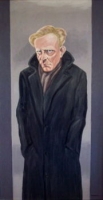| Aðalsteinn Kristmundsson | |||||
Read works of Steinn Steinarr at 诗海 | |||||
Lífs um angurs víðan vang
víst ég ganginn herði,
eikin spanga, í þitt fang
oft mig langa gerði. Across life's broad plain of grief
I surely quickened my pace;
oh lady, in your embrace
often I did long to be.
This is not only a perfect imitation of the style of the rímur, with the sometimes inherent repetitiveness of syntax and kenningar (heiti happen to be absent here), but it has just that little bit of its author's own to make it art in its own right too.
Another stanza actually makes the whole point clear (I 4):
Þó ég meini þetta og hitt,
þér ég reyna vil að segja:
þú ert eina yndið mitt
unz ég seinast fer að deyja. Although I mean this and that,
I want to try to tell you:
you alone are my darling
until at last I die.
Here are no poetical circumlocutions, just ice-cold irony.
His best known work is Time and the Water, of which the following is the first part.
Tíminn er eins og vatnið,
og vatnið er kalt og djúpt
eins og vitund mín sjálfs.
Og tíminn er eins og mynd,
sem er máluð af vatninu
og mér til hálfs.
Og tíminn og vatnið
renna veglaust til þurrðar
inn í vitund mín sjálfs.
(Quoted from ljod.is) Time is like the water,
and the water is cold and deep
like my own consciousness.
And time is like a picture,
which is painted of water,
half of it by me.
And time and the water
flow trackless to extinction
into my own consciousness.
(Translation by Marshall Brement)
Steinn satirized anything and everything, and spared nobody, as can be seen from Ein sorgleg vísa um Sósíalistaflokkinn og mig (One Tragic Poem about the Socialist Party and Me - Steinn was a Socialist). A very famous poem is Passíusálmur No. 51. The title is a reference to the Passíusálmar of Hallgrímur Pétursson. Hallgrímur wrote 50 psalms, and Steinn added this:
Á Valhúsahæðinni
er verið að krossfesta mann.
Og fólkið kaupir sér far
með strætisvagninum
til þess að horfa á hann.
Það er sólskin og hiti,
og sjórinn er sléttur og blár.
Þetta er laglegur maður
með mikið enni
og mógult hár.
Og stúlka með sægræn augu
segir við mig:
Skyldi manninum ekki leiðast
að láta krossfesta sig? There's a man being crucified
on Valhúsahæðin hill.
And people buy themselves a ride
on the bus
to watch him.
There's sunshine and warmth,
and the sea is calm and blue.
This is a fine looking man
with a high forehead
and golden brown hair.
And a girl with sea-green eyes
says to me:
Won't the man get bored
of being crucified?
Here the crucifixion is shown in an Icelandic setting, probably as the little girl imagines it when she asks whether it isn't dull for the man to be crucified. The metre is new, but not without such traditional devices as rhyme and alliteration, making this a poem to be appreciated read aloud.
References
Steinn Steinarr (1964). Kvæðasafn og greinar. Helgafell.
Steinn Steinarr Biography in Icelandic
Brement, Marshall (1985). Three Modern Icelandic Poets. Reykjavík: Iceland Review.
This article about an Icelandic writer or poet is a stub. You can help Wikipedia by expanding it.
This article about a poet is a stub. You can help Wikipedia by expanding it.
